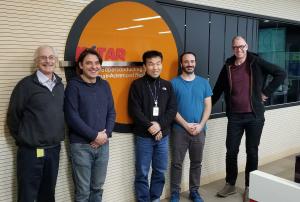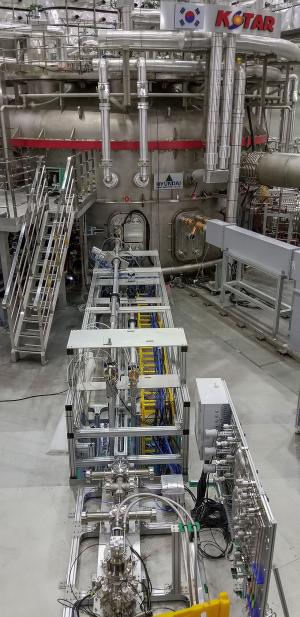ITER-like disruption mitigation at KSTAR
Two weeks ago at the Korean tokamak KSTAR, the technology chosen for disruption mitigation at ITER—shattered pellet injection—was tested for the first time in an ITER-like dual-injection configuration.
To lessen the impact of high-energy plasma disruptions that can lead to significant thermal loading of in-vessel components, an international task force is leading an extensive program to validate the design of an effective disruption mitigation system.
The design work of the ITER disruption mitigation system is driven by a team of engineers that was formed in 2019 at the ITER Organization, after the responsibility for the system was taken over from the US Domestic Agency. This team continues what has been developed at the Oak Ridge National Laboratory (ORNL) as a voluntary US contribution, progressing the design with high intensity in order to have it ready to integrate into port plug designs by 2022. In parallel, the task force is investing in optimizing key technologies as well as validating the functionality of the design. The first large-scale experimental project of the task force is the KSTAR shattered pellet injector project.
ITER's disruption mitigation strategy is based on the injection of cryogenic pellets from different toroidal locations into plasmas that are unstable and will disrupt. This method aims to decrease electromagnetic and thermal loads to machine components.
Just before they enter the plasma chamber, these pellets—which have a diameter of 28.5 mm and a length of more than 50 mm—are shattered into small fragments. This concept ensures that the frozen deuterium and neon is ablated and assimilated by the plasma to achieve the high densities that are required for disruption mitigation. The plasma thermal and magnetic energy will be dissipated through radiation rather than leading to large heat loads and electromagnetic forces.
With the present design, up to 24 pellets can be fired from three equatorial port plugs into the ITER plasma. The distribution of injection locations aims at keeping the plasma radiation as uniform as possible to avoid melting of the first wall; moreover, injecting from different locations around the torus can also affect how efficiently the injected particles are absorbed by the plasma. In ITER, two of the injection locations are exactly opposite one another—and it is the goal of the KSTAR experiments to test this configuration.
In mid-2018 four parties began detailed discussions on how to implement the two shattered pellet injectors on KSTAR: Korea's National Fusion Research Institute, NFRI (the lab operating KSTAR), US ITER through ORNL (the lab providing injector hardware), and the ITER Organization through the Disruption Mitigation System Task Force to coordinate the project and to provide a framework for the scientific exploitation.
From the beginning, it was clear that time was limited and the amount of work necessary for installation would be substantial. The motivation and persistence of all parties—the engineers and physicists at KSTAR, who found space on the device despite the fact that most of the access ports were already well occupied with diagnostics and heating systems, and the ORNL team, with its experience in installing and operating shattered pellet injection systems at DIII-D and JET—turned out to be decisive. In a short time, ORNL designed the system that would be needed for KSTAR, NFRI rebuilt two of the large KSTAR ports to accommodate the system's flight tubes, the platform around the tokamak was extended to accommodate the injector hardware, and control cubicles, gas and cryogenic lines were put in place.
In August 2019, KSTAR was closed and pumping began in preparation for the experimental campaign. Less than one year after the first contract had been signed, in November, one of the two injectors fired pellets into the KSTAR plasma. Now, two months later, the second injector has entered service. Experiments have been performed to get a first glimpse of how the plasma reacts on dual pellet injection.
Diagnosing the plasma with the appropriate equipment is essential for all tokamak experiments, but disruptive plasmas—due to the short timescales of a few milliseconds and the huge dynamic ranges required—are especially challenging and most diagnostics installed on present-day tokamaks are not optimized for such conditions.
Through ITER Organization funding, the KSTAR shattered pellet injection team installed several dedicated diagnostics to analyze the effectiveness of the injection:
- Electron, photon, X-ray (AXUV) diodes inside the vacuum vessel to allow tomographic reconstruction of the radiation in two toroidal locations together with several wide-angle detectors toroidally distributed. These instruments measure the radiated power and especially its spatial distribution during the different phases of the disruption.
- A dispersion interferometer at a wavelength of 1064 nm with three channels viewing different locations in the plasma. Because the aim of disruption mitigation through shattered pellet injection is to increase the electron density in the plasma by more than a factor 20 during normal operation, resolving such densities requires interferometers that are not compromised by refraction.
The initial results of the first dual injection experiments indicate that significantly higher density can be achieved when using two injectors. However, it is also clear that the timing of the arrival of the two pellets is critical—a few milliseconds' delay of one of the pellets can already degrade the mitigation performance. This is a critical aspect for the ITER mitigation strategy since it relies on the injection of several pellets to achieve the required densities.
Finally, the observation of the penetration of the ice fragments into the plasma is indispensable for the interpretation of the experiments. For this purpose, KSTAR will be equipped this year with two ultra-fast cameras observing the injection locations, before experiments resume after summer.
The KSTAR shattered pellet injection project is one of several experimental activities of the ITER Disruption Mitigation System Task Force, and it complements the JET shattered pellet injection experiments that were made possible through substantial support from the ITER Organization and an international effort of several labs.
Such experiments will provide critical information to validate models that will eventually predict the performance of shattered pellet injection in ITER and guide the disruption mitigation design team in taking decisions.



